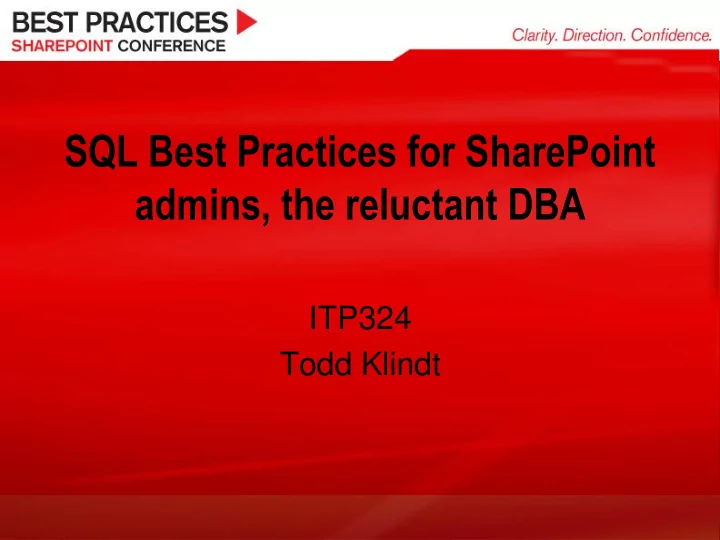

SQL Best Practices for SharePoint admins, the reluctant DBA ITP324 Todd Klindt
Todd Klindt, MVP Solanite Consulting, Inc. http://www.solanite.com http://www.toddklindt.com/blog todd@solanite.com Author, Inside SharePoint 2007 Administration and Real World SharePoint 2007 . Speaker at many conferences
Session Agenda Overview of how SharePoint uses SQL Overview of SQL versions and which you would use for what Care and feeding Best Practices for your SQL server A couple of cool SQL 2008 features to consider
SQL? I’m a SharePoint admin! WSS & MOSS Farm configuration is stored in SQL. All SharePoint content is stored in SQL. No exceptions! * Central Admin is a site collection and is in its own content database Search gets its own database • * Except one.
Content Databases A farm may have multiple Content Databases A Site Collection must exist completely in a single Content Database A Content Database may have multiple Site Collections Multiple SSP databases
Which version of SQL? SQL 2005 or 2008 SQL 2000 64 bit 32 bit Basic Install
Standard or Enterprise? Standard features Supports up to 4 CPUs (including cores) Supports OS Maximum RAM, 4 GB of RAM on 32 bit OS Failover is manual and restricted to two nodes Supports Database Mirroring Native 64 bit support
Movin ’ on up. Full SQL 2005 functionality Supports more than 4 CPUs Support for up to 32 GB of RAM on 32 bit OS, OS limitation, not SQL’s Active failover for mirrors KPI and Analysis Server built in Comparison chart of all the versions at http://www.microsoft.com/sql/prodinfo/feature s/compare-features.mspx
Keep your SQL server happy Maintenance Plans Can be created manually or with a wizard Easily modified with a graphical interface Can include a variety of operations, including backups Can use SMTP to email plan success
What should I do in these? Check Database Integrity Reindex or Rebuild database Indexes Update Statistics Backups Defrag the file system
Things you should do Check Database Integrity Verifies integrity of databases Uses T-SQL command DBCC checkdb Very disk and CPU intensive
Statistics Update Statistics Statistics help the DB engine decide the most optimal execution path Updating these statistics improves the efficiency of queries You might trigger it manually if there were a lot of records added or deleted Happens automatically, you should not have to run manually
Indexes Reindex databases Defragments database indexes Rebuild Index Completely recreates the database index Not needed as often Shrinking databases fragments your indexes and your data.
Backups Can be part of maintenance plan. Three types Full Partial Differential Transaction logs
More Backup best practices Can use built in software or third party. Idera and Quest software allow for database compression and encryption. Results in smaller backups Could also result in faster backups, if drive speed is the bottleneck SQL 2008 Enterprise support compression and encryption out of the box
File system fragmentation SQL will be faster if the database files are contiguous in the file system Using the built in defrag tool will have performance ramifications Consider using something like Diskeeper and its intelligent defrag. Consider stopping SQL if possible
Drink me Database size is reduced by dropping unused space. Do not shrink databases unless something drastic has happened Massive site or content deletions Removing site collections from v2 databases Abandoning databases Has a heavy impact on the server
Eat me Databases grow, it is what they do Grow operations are slow in SQL and will likely result in a fragmented database file Create database with enough space for one year’s worth of growth
Database Best Practices Create multiple TempDB files Put database and corresponding transaction logs on different spindles Arrange databases according to speed Use autogrow sparingly Keep your databases under 100 GB Use multiple content databases
More points to ponder Do not alter databases. Microsoft HATES that If using SQL 2005, install SP2 Can use SharePoint farm backups to back up SQL Don’t forget your System databases SharePoint SP1 supports SQL 2008
Here we’ll look at some of the things we’ve covered A LITTLE NOODLING AROUND IN SQL
Thank you for attending! (This slide must always be the last slide in your deck) Please be sure to fill out your session evaluation!
Recommend
More recommend